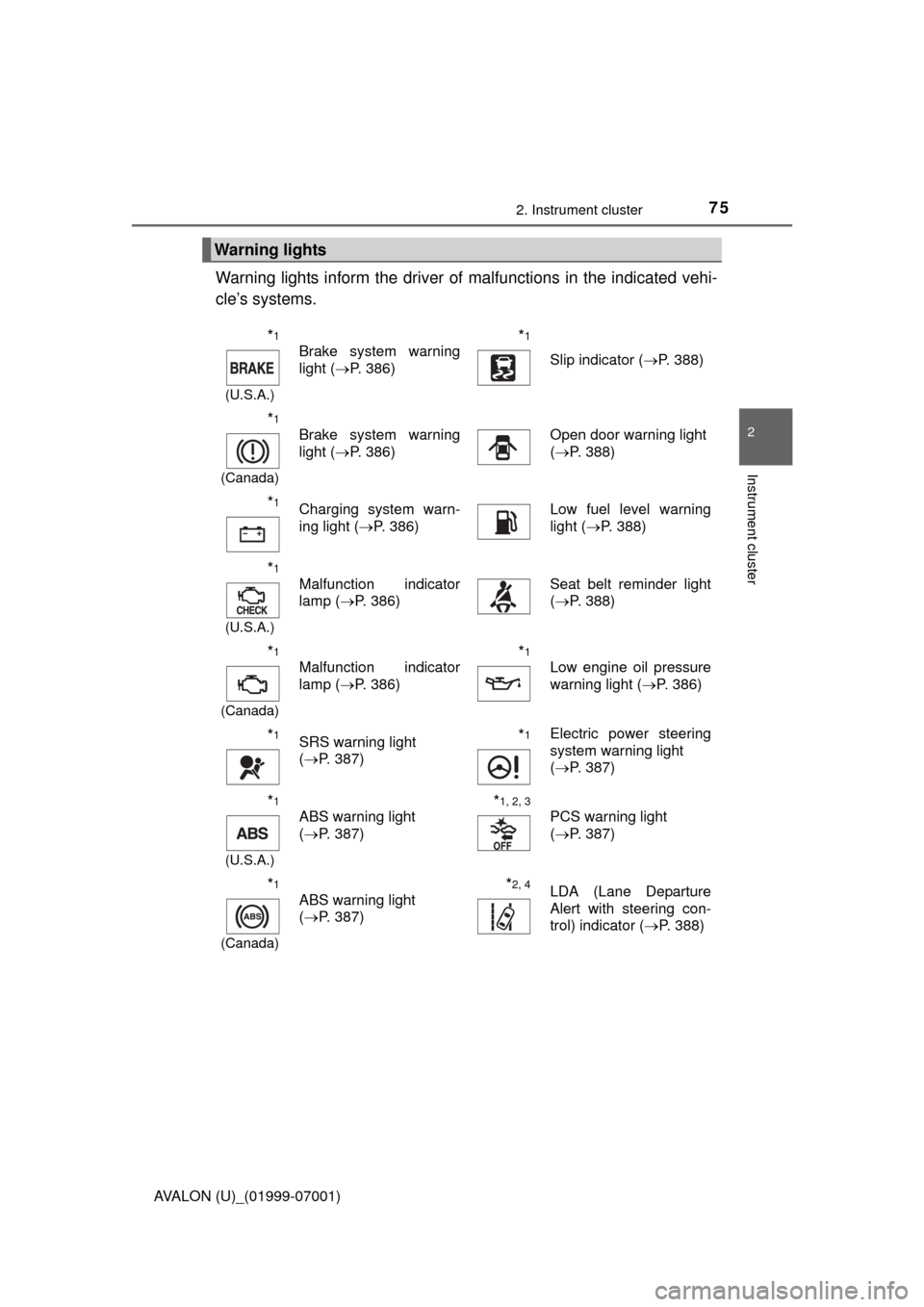2016 TOYOTA AVALON power steering
[x] Cancel search: power steeringPage 2 of 492

TABLE OF CONTENTS2
AVALON (U)_(01999-07001)For your information....................... 8
Reading this manual .................... 12
How to search .............................. 13
Pictorial index .............................. 14
1-1. For safe use
Before driving ...................... 24
For safety drive ................... 26
Seat belts ............................ 28
SRS airbags ........................ 34
Front passenger occupant classification system ......... 46
Safety information for children ............................. 52
Child restraint systems ........ 53
Installing child restraints ...... 57
Exhaust gas precautions ..... 67
1-2. Theft deterrent system Engine immobilizer system............................... 68
Alarm ................................... 70
Theft prevention labels (U.S.A.) ............................. 72
2. Instrument cluster Warning lights and indicators........................... 74
Gauges and meters............. 79
Multi-information display ..... 82
Fuel consumption information ........................ 89 3-1. Key information
Keys..................................... 92
3-2. Opening, closing and locking the doors
Doors ................................... 97
Trunk ................................. 103
Smart key system .............. 108
3-3. Adjusting the seats Front seats......................... 119
Driving position memory ........................... 121
Head restraints .................. 126
3-4. Adjusting the steering wheel and mirrors
Steering wheel ................... 128
Inside rear view mirror ....... 130
Outside rear view mirrors ............................. 132
3-5. Opening, closing the windows and
moon roof
Power windows.................. 135
Moon roof .......................... 138
1For safety and security
2Instrument cluster
3Operation of
each component
Page 75 of 492

752. Instrument cluster
2
Instrument cluster
AVALON (U)_(01999-07001)
Warning lights inform the driver of malfunctions in the indicated vehi-
cle’s systems.
Warning lights
*1
(U.S.A.)
Brake system warning
light ( P. 386)*1
Slip indicator ( P. 388)
*1
(Canada)
Brake system warning
light (P. 386)Open door warning light
(P. 388)
*1Charging system warn-
ing light ( P. 386)Low fuel level warning
light (P. 388)
*1
(U.S.A.)
Malfunction indicator
lamp ( P. 386)Seat belt reminder light
(P. 388)
*1
(Canada)
Malfunction indicator
lamp ( P. 386)*1
Low engine oil pressure
warning light ( P. 386)
*1SRS warning light
(P. 387)*1Electric power steering
system warning light
(P. 387)
*1
(U.S.A.)
ABS warning light
(P. 387)*1, 2, 3
PCS warning light
(P. 387)
*1
(Canada)
ABS warning light
(P. 387)*2, 4LDA (Lane Departure
Alert with steering con-
trol) indicator ( P. 388)
Page 91 of 492

91
Operation of
each component
3
AVALON (U)_(01999-07001) 3-1. Key information
Keys .................................... 92
3-2. Opening, closing and locking the doors
Doors .................................. 97
Trunk ................................. 103
Smart key system ............. 108
3-3. Adjusting the seats Front seats ........................ 119
Driving position memory ........................... 121
Head restraints.................. 126
3-4. Adjusting the steering wheel and mirrors
Steering wheel .................. 128
Inside rear view mirror ...... 130
Outside rear view mirrors ............................. 132
3-5. Opening, closing the windows and
moon roof
Power windows ................. 135
Moon roof .......................... 138
Page 147 of 492

1474-1. Before driving
4
Driving
AVALON (U)_(01999-07001)
WARNING
Observe the following precautions.
Failure to do so may result in death or serious injury.
■When driving the vehicle
●During normal driving, do not turn off the engine. Turning the engine off
while driving will not cause loss of steering or braking control, but the
power assist to these systems will be lost. This will make it more difficult to
steer and brake, so you should pull over and stop the vehicle as soon as it
is safe to do so.
However, in the event of an emergency, such as if it becomes impossible
to stop the vehicle in the normal way: P. 379
● Use engine braking (downshift) to maintain a safe speed when driving
down a steep hill.
Using the brakes continuously may cause the brakes to overheat and lose
effectiveness. ( P. 165)
● Do not adjust the positions of the steering wheel, the seat, or the inside or
outside rear view mirrors while driving.
Doing so may result in a loss of vehicle control.
● Always check that all passengers’ arms, heads or other parts of their body
are not outside the vehicle.
● Do not drive in excess of the speed limit. Even if the legal speed limit per-
mits it, do not drive over 85 mph ( 140 km/h) unless your vehicle has high-
speed capability tires. Driving over 85 mph (140 km/h) may result in tire
failure, loss of control and possible injury. Be sure to consult a tire dealer
to determine whether the tires on y our vehicle are high-speed capability
tires or not before driving at such speeds.
Page 152 of 492

1524-1. Before driving
AVALON (U)_(01999-07001)
NOTICE
■When driving the vehicle
●Do not depress the accelerator and brake pedals at the same time during
driving, as this may restrain driving torque.
● Do not use the accelerator pedal or depress the accelerator and brake
pedals at the same time to hold the vehicle on a hill.
■ When parking the vehicle
Always shift the shift lever to P. Failure to do so may cause the vehicle to
move or the vehicle may accelerate suddenly if the accelerator pedal is
accidentally depressed.
■ Avoiding damage to vehicle parts
●Do not turn the steering wheel fully in either direction and hold it there for
an extended period of time.
Doing so may damage the power steering motor.
● When driving over bumps in the road, drive as slowly as possible to avoid
damaging the wheels, underside of the vehicle, etc.
■ If you get a flat tire while driving
A flat or damaged tire may cause the following situations. Hold the steering
wheel firmly and gradually depress the brake pedal to slow down the vehi-
cle.
●It may be difficult to control your vehicle.
● The vehicle will make abnormal sounds or vibrations.
● The vehicle will behave abnormally.
Information on what to do in case of a flat tire ( P. 395)
Page 162 of 492

1624-2. Driving procedures
AVALON (U)_(01999-07001)
■Auto power off function
If the vehicle is left in ACCESSORY mode for more than 20 minutes or IGNI-
TION ON mode (the engine is not running) for more than an hour with th\
e
shift lever in P, the engine switch will automatically turn off. However, this
function cannot entirely prevent battery discharge. Do not leave the vehicle
with the engine switch in ACCESSORY or IGNITION ON mode for long peri-
ods of time when the engine is not running.
■ Electronic key battery depletion
P. 9 4
■ Conditions affecting operation
P. 1 1 4
■ Notes for the entry function
P. 1 1 5
■ If the engine does not start
●The engine immobilizer system may not have been deactivated. ( P. 68)
Contact your Toyota dealer.
● Check that the shift lever is securely set in P. The engine may not start if the
shift lever is displaced out of P.
■ Steering lock
After turning the engine switch off and opening and closing the doors, the
steering wheel will be locked due to the steering lock function. Operating the
engine switch again automatically cancels the steering lock.
Page 164 of 492

1644-2. Driving procedures
AVALON (U)_(01999-07001)
WARNING
■When starting the engine
Always start the engine while sitting in the driver’s seat. Do not depress the
accelerator pedal while starting the engine under any circumstances.
Doing so may cause an accident resulting in death or serious injury.
■ Caution while driving
If engine failure occurs while the vehicle is moving, do not lock or open the
doors until the vehicle reaches a safe and complete stop. Activation of the
steering lock in this circumstance may lead to an accident, resulting in
death or serious injury.
■ Stopping the engine in an emergency
If you want to stop the engine in an emergency while driving the vehicle,
press and hold the engine switch for more than 2 seconds, or press it briefly
3 times or more in succession. ( P. 379)
However, do not touch the engine switch while driving except in an emer-
gency. Turning the engine off while driving will not cause loss of steering or
braking control, but the power assist to these systems will be lost. This will
make it more difficult to steer and brake, so you should pull over and stop
the vehicle as soon as it is safe to do so.
NOTICE
■ To prevent battery discharge
●Do not leave the engine switch in ACCESSORY or IGNITION ON mode
for long periods of time without the engine running.
● Do not stop the engine when the shift lever is in a position other than P. If
the engine is stopped in another shift lever position, the engine switch will
not be turned off but instead be turned to ACCESSORY mode. If the vehi-
cle is left in ACCESSORY mode, battery discharge may occur.
■ When starting the engine
●Do not race a cold engine.
● If the engine becomes difficult to star t or stalls frequently, have your vehi-
cle checked by your Toyota dealer immediately.
■ Symptoms indicating a malfunction with the engine switch
If the engine switch seems to be operating somewhat differently than usual,
such as the switch sticking slightly, there may be a malfunction. Contact
your Toyota dealer immediately.
Page 248 of 492

2484-5. Using the driving support systems
AVALON (U)_(01999-07001)
◆ABS (Anti-lock Brake System)
Helps to prevent wheel lock when the brakes are applied suddenly,
or if the brakes are applied while driving on a slippery road surface
◆Brake assist
Generates an increased level of braking force after the brake pedal
is depressed when the system detects a panic stop situation
◆VSC (Vehicle Stability Control)
Helps the driver to control skidding when swerving suddenly or
turning on slippery road surfaces
◆TRAC (Traction Control)
Helps to maintain drive power and prevent the drive wheels from
spinning when starting the vehicle or accelerating on slippery roads
◆EPS (Electric Power Steering)
Employs an electric motor to redu ce the amount of effort needed to
turn the steering wheel
◆BSM (Blind Spot Monitor) (if equipped)
P. 2 3 7
Driving assist systems
To help enhance driving safety and performance, the following
systems operate automatically in response to various driving
situations. Be aware, however, that these systems are supple-
mentary and should not be relied upon too heavily when operat-
ing the vehicle.